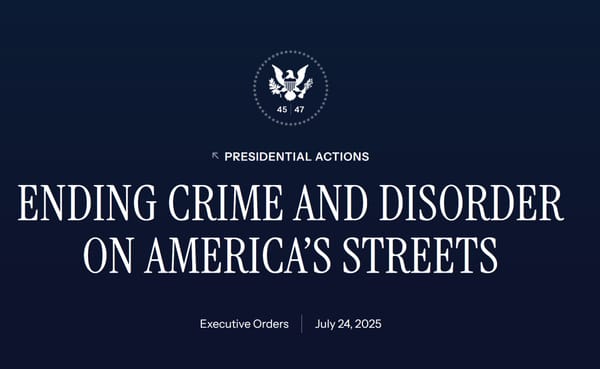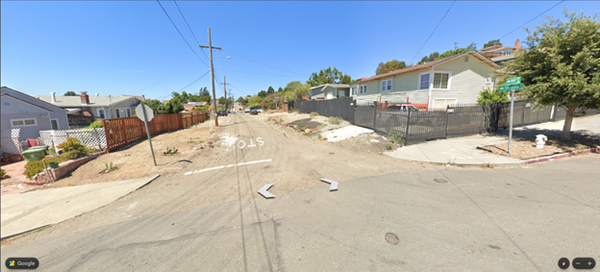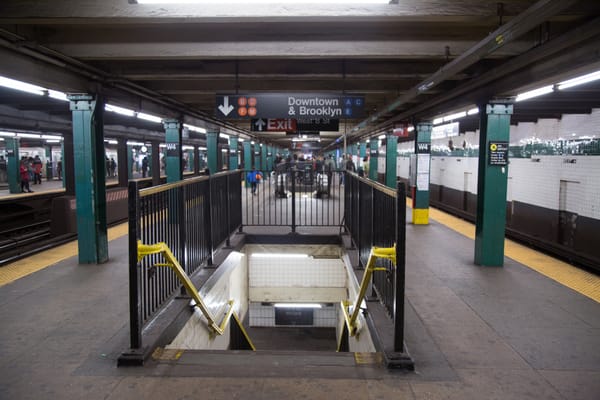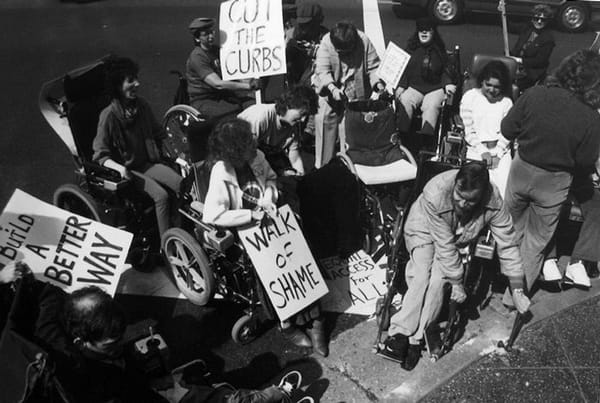Let's start with the good this time

What's good these days?
Not everything is as doom and gloom as last week 's newsletter made it out to be. The Guardian has a nice feature on street tree-planting initiatives from London to Philly to Singapore. Community members come together to plant, tend, and replace street trees, with the knowledge that they'll have the biggest benefits years or decades down the road (after many of the planters have left). And those street trees have huge benefits, especially in the face of climate change:
As temperatures rise, research has shown that urban trees can play a fundamental role in keeping cities cool, evaporating water to provide a natural form of air-conditioning, cooling air temperatures and reducing the urban heat island effect. Work by Friends of the Earth in five English cities in 2023 showed that areas with more trees and greenery were up to 5C cooler.
Now, extreme heat is a huge disability climate justice issue for two main reasons. The first is physiological: many disabilities and disability-related medications (especially psychiatric meds) make people more likely to experience health consequences of excessive or extreme heat – such as heat exhaustion or heatstroke – compared to an able-bodied person in the same environment. The second reason is all the external factors putting people with disabilities (PWDs) at risk, such as substandard housing (mostly around insulation and HVAC), limited finances (e.g., for cooling bills or home upgrades), or frequent use of public transit with all its waiting for buses and trains (meanwhile, Paratransit can have hours-long pickup windows and may require poorly-timed transfers at agency boundaries).
Environmental changes that limit extreme heat disproportionately benefit PWDs because they reduce a climate impact that hits us especially hard. In the case of these tree planting efforts, there’s a clear justice component. Because they are largely focused on neighborhoods without many trees – which also tend to have lower property values, lower income residents, and, by extension, a higher-than-average share of disabled residents – they are reducing inequities in tree cover with clear benefits for PWDs. The community-building that comes with planting street trees can also benefit disabled folks. PWDs who participate in tree planting efforts (even as organizers or cheerleaders) get the immediate benefits of community, while a more diverse planting army increases able-bodied tree planters’ disability interactions and thus awareness (which may make them more inclined to support people with disabilities and our issues, as well).
Tuesday marked 100 days since the launch of New York City’s Congestion Pricing program, and so far the results are fantastic. Curbed notes that:
In those 100 days, 6 million fewer cars drove into lower Manhattan than had done so a year earlier. In March, the decrease was 80,000 per day. In the congestion zone, we’re seeing half as many traffic-related injuries. The bus routes in Manhattan are so much less clogged that the drivers are being forced to slow down to maintain their schedules… The diminished honking is a bonus.
There are clear benefits to PWDs here. Just on the injury front, one study found that “from 2006 to 2012, the mortality rate for pedestrians using wheelchairs was… 36% higher than the overall population pedestrian mortality rate,” and many other studies identified higher risks of collisions for specific disability categories plus disability as a whole (several showed at least a 2x risk factor, with one over 5x). And more efficient transit means disabled folks can get where they want to faster and more reliably. Julia Michelson, Deputy chief of the MTA, told Curbed that “totally anecdotally, doctors are reporting that their patients are not late for appointments.” (Of course, PWDs do far more than go to doctors’ appointments, but it can be a major problem when we miss one given the wait to see specialists and whatnot).
The Urbanist reports that Seattle is moving to “extend permit applications and existing permits for projects that had initially been submitted under the city’s 2015 and 2018 building code,” which will prevent the need for major redesigns that could add significant costs and possibly lead to canceled projects. About 3000 projects representing 34,000 units could be affected, which is huge. Parking reform also passed both chambers of the Washington legislature on Friday, April 11. Parking reform is crucial to accelerating housing construction, enabling lower-rent new apartments, and reducing car trips (with all their carbon emissions and injuries). So, good stuff is coming out of the Apple State.
In other good news (it’s limited, I know… But please drop your good news stories in the comments!):
Meet the Montreal Mayor Who Declared War on SUVs – Bloomberg CityLab
Sean Duffy keeps fighting with New York—good luck with that – Daily Kos
Could a CSU’s dorm solution help fix California’s housing crisis? – San Francisco Chronicle (story about a 4200-unit modular housing project)
Texas High-Speed Rail Issues Update After Trump Snub – Newsweek
And now, the bad news
Last week, I mentioned that tariffs will hit PWDs especially hard due to our disproportionately low income and our use of durable medical equipment (DME), disposable medical supplies and medications that are manufactured overseas. On Friday, Mother Jones published a piece that goes into more detail on the DME side. It points out that “around 75 percent of US-marketed medical devices are, at least in part, manufactured abroad” and that numbers for some categories, like respiratory devices, are even higher. A huge portion of DME is manufactured, at least in part, in China, which has been slapped with absurd 145% tariffs – a price that’ll be paid by insurers (including Medicare and Medicaid) and consumers.
This will all be felt especially hard by Medicaid recipients as state Medicaid programs figure out what to do with higher costs. Among other things, people may be forced to ration supplies or pay escalating costs out-of-pocket (a big ask for low-income folks on Medicaid). An expert quoted in the article thinks we may see Medicaid put caps on DME, with plenty of downstream consequences. Looking forward, at least some manufacturing will try to move from China toward less-tariffed countries, but the FDA must inspect those factories before they can export to the US – and the FDA’s been decimated, creating delays for inspections and certifications. And of course, the expected Medicaid cuts weaving through Congress will combine with tariffs to make things even worse.
The New York Times reports that the Trump administration is planning to significantly scale back housing assistance, including Section 8 vouchers. Things are still early, and we’ll know more after Trump sends his new budget to Congress:
Administration officials recently discussed cutting or canceling out the vouchers and other rental assistance programs and potentially replacing them with a more limited system of housing grants, perhaps sent to states, according to three people familiar with the matter, who spoke on the condition of anonymity to describe the confidential discussions. The overhaul would be included in President Trump’s new budget, which is expected to be sent to Capitol Hill in the coming weeks.
As you’d expect, PWDs are a disproportionately high percentage of HUD-supported renters. Per 2024 HUD data, 23% of all persons in public housing have a disability and 26% of people living in Housing Choice Vouchers (a.k.a. Section 8) homes have a disability. Numbers are even higher when looking at the household head, their spouse, or the co-head: for example, in Housing Choice Voucher homes, 34% of heads, spouses or co-heads aged 61 or less had a disability, and the number is 67% for those aged 62 and up. There’s also tremendous demand for Section 8 and other subsidized housing: citing Eric Oberdorfer from the National Association of Housing and Redevelopment Officials, the Times notes that “only one in four families eligible for vouchers are able to obtain them because of funding constraints.” Oberdorfer draws the logical conclusion that “[i]f there were to be a cut to the voucher program, essentially, you would see a decrease to the number of families that are served by the program.” The rest would languish on already-excessive wait lists while having their budgets squeezed or experiencing housing insecurity (or both).
Like many White House budget-slashing efforts, fully eliminating Section 8 is the idea of Russell Vought, the director of the Office of Management and Budget. His supposed problems with Section 8 have tones of conservative NIMBYism (saying it brings crime and decreases property values), Reagan-era anti-welfarism (it “results in dependency and subsidized irresponsibility”), and Trumpian attacks on diversity, equity, and inclusion (it’s a “hook for implementing the left’s fair housing agenda”). These are, of course, absolute bunk and bigoted ideas in general – and gross justifications to eliminate the program – but it’s April 2025, so bunk and bigoted ideas are what's driving federal policy. I wish it weren't so.
In other not-good news:
How SUVs Are Making Traffic Worse – Bloomberg CityLab
Lawsuits take aim at voter-approved transit projects worth billions – AZ Mirror/States Newsroom
People with disabilities struggle to find space in Chicago’s homeless shelters: ‘Let’s hope for better things to come’ – Chicago Tribune
As DOGE slashes services, disability advocates fight to maintain government lifelines – Salon
US single-family housing starts tumble to an eight-month low in March – Reuters (however, “[s]tarts for housing projects with five units or more were unchanged at a rate of 371,000 units”).
Brain drain at Census Bureau has employees warning about the country's statistics – NPR (important because good data informs good public engagement and policy across disability, urbanism, and climate… and, well, everything)




